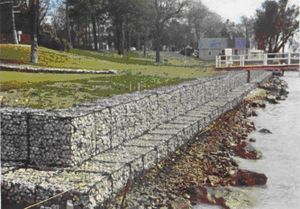Difference between revisions of "Bulkheads"
m (→Further reading) |
|||
| Line 1: | Line 1: | ||
| − | Bulkheads are normally smaller than seawalls, as their primary function is to retain fill at locations with only limited wave action, and not to resist coastal erosion. A bulkhead must, of course, be designed to resist erosion caused by the mild to moderate wave climate at a specific site. | + | Bulkheads are normally smaller than [[seawall|seawalls]], as their primary function is to retain fill at locations with only limited wave action, and not to resist coastal erosion. A bulkhead must, of course, be designed to resist erosion caused by the mild to moderate wave climate at a specific site. |
A bulkhead cannot really be characterised as a coast protection structure; it is rather a structure that is used to retain fills along the water perimeter of reclaimed areas and in port basins. The following article discusses applications of bulkeads. | A bulkhead cannot really be characterised as a coast protection structure; it is rather a structure that is used to retain fills along the water perimeter of reclaimed areas and in port basins. The following article discusses applications of bulkeads. | ||
==Method== | ==Method== | ||
| − | Bulkheads are normally constructed in the form of a vertical wall built in concrete, stone, steel or timber. The concrete, steel or timber walls can be piled and anchored walls, whereas the concrete and stone walls can also be constructed as gravity walls. Special mesh boxes containing stones, e.g. the Gabion type, are also used. | + | Bulkheads are normally constructed in the form of a vertical wall built in concrete, stone, steel or timber. The concrete, steel or timber walls can be piled and anchored walls, whereas the concrete and stone walls can also be constructed as gravity walls. Special mesh boxes containing stones, e.g. the [[gabions|Gabion]] type, are also used. |
[[Image:Bulkhead.jpg|thumb|Fig. 1. Example of bulkhead structure constructed by Gabion mesh boxes.]] | [[Image:Bulkhead.jpg|thumb|Fig. 1. Example of bulkhead structure constructed by Gabion mesh boxes.]] | ||
| Line 11: | Line 11: | ||
==Applicability== | ==Applicability== | ||
| − | Bulkheads function well as a separation between land and sea in marina basins, and along protected shorelines. They are used along natural shorelines and along filled areas, where a well-defined separation between land and sea is required. | + | Bulkheads function well as a separation between land and sea in marina basins, and along protected [[shoreline|shorelines]]. They are used along natural shorelines and along filled areas, where a well-defined separation between land and sea is required. |
| − | |||
| − | |||
| − | |||
==References== | ==References== | ||
Revision as of 13:18, 14 December 2007
Bulkheads are normally smaller than seawalls, as their primary function is to retain fill at locations with only limited wave action, and not to resist coastal erosion. A bulkhead must, of course, be designed to resist erosion caused by the mild to moderate wave climate at a specific site.
A bulkhead cannot really be characterised as a coast protection structure; it is rather a structure that is used to retain fills along the water perimeter of reclaimed areas and in port basins. The following article discusses applications of bulkeads.
Method
Bulkheads are normally constructed in the form of a vertical wall built in concrete, stone, steel or timber. The concrete, steel or timber walls can be piled and anchored walls, whereas the concrete and stone walls can also be constructed as gravity walls. Special mesh boxes containing stones, e.g. the Gabion type, are also used.
Functional characteristic
The function of a bulkhead is, in protected environments, to retain or prevent the sliding of land at the transition between the land, filled or natural, and the sea.
Applicability
Bulkheads function well as a separation between land and sea in marina basins, and along protected shorelines. They are used along natural shorelines and along filled areas, where a well-defined separation between land and sea is required.
References
Further reading
- Mangor, Karsten. 2004. “Shoreline Management Guidelines”. DHI Water and Environment, 294pg.
Please note that others may also have edited the contents of this article.
|
